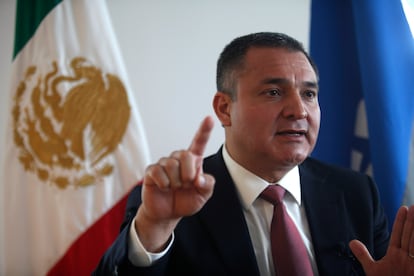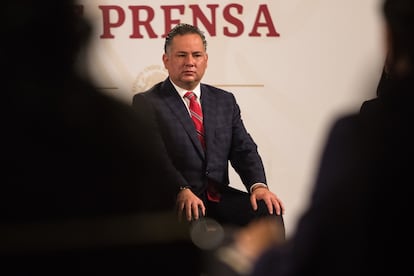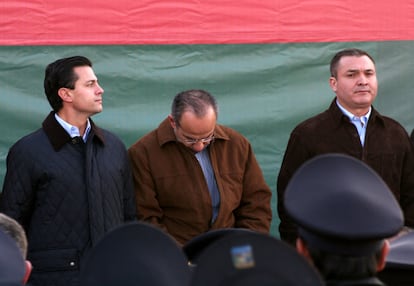Mexico and US on parallel course to probe fortune of ex-drug czar García Luna
The Mexican government has filed a suit in Florida accusing the former security official of diverting over $750 million in public funds, while a NY court is trying him for allegedly taking bribes from the Sinaloa Cartel

On October 18, 2021 the government of Mexico sent a letter addressed to inmate number 59745-177 at the Brooklyn Metropolitan Detention Center in New York. Genaro García Luna, imprisoned for drug trafficking and organized crime in the United States, was receiving official notice that the authorities in his own country were also going to initiate legal action against him. “Deliberately and illegally, you obtained or used a total of at least $250 million that rightfully belongs to the United Mexican States,” the document reads.
The civil lawsuit, brought by the Financial Intelligence Unit (UIF), claims that the former secretary of public security took advantage of his connections after leaving his post and led a corrupt scheme that diverted public funds to create a real estate “empire” in Florida. The bombshell was leaked to the media practically at the same time as García Luna sat inside a New York courthouse at the start of a criminal trial in in which he is accused of collaborating with the Sinaloa Cartel for more than 20 years. Running along parallel lines, these two different legal avenues are both following a trail of corrupt money: American authorities are probing the bribes that the former security chief allegedly took from drug operatives to let the notorious cartel operate with impunity as it sent tons of cocaine to the US, while Mexican officials are after him for fraud and embezzlement, with damages amounting to up to an estimated $750 million.
The legal battle of the United States and Mexico against García Luna is running along two separate tracks. The trial in New York is a criminal case against the former head of the Federal Police force, but it also has an economic side, since he is accused of receiving “tens of millions of dollars” in bribes from drug traffickers since 2001, just a few months after taking over as director of the Federal Investigation Agency (AFI), created during the government of Vicente Fox (2000-2006). The former official’s ties to organized crime became especially close when he was Secretary of Public Security in the Felipe Calderón Administration (2006-2012), but they continued for several more years, even after his arrest in 2019 in Texas, according to the prosecution. On the other hand, the case that the Mexican authorities built against García Luna is a civil lawsuit in Florida. Civil cases do not entail prison terms, but usually require the defendant to pay money if found guilty.

There is no precedent for the Mexican government’s use of such a legal strategy to recover fortunes amassed by acts of corruption that ended up in other countries. “What we are going to try is to collect the money, that is up to us,” said Mexican President Andrés Manuel López Obrador, who has taken advantage of the criminal trial in New York to put Mexico’s claim in the Miami court high on the agenda. The president has made it clear that the legal action against García Luna is one of his highest priorities and that it will be a recurring theme in his daily news conferences. The president had already complained on several occasions that the US usually keeps the wealth that politicians and drug traffickers build through criminal acts or corruption committed in Mexico. “It’s a judicial drama,” he said about the criminal trial.
The UIF’s battle has not been easy. Even in Mexico itself, it was the subject of controversy and friendly fire within the federal government. The initial lawsuit was filed before the Court of the Eleventh Judicial District of Florida on September 21, 2021, a few weeks before Santiago Nieto stepped down from UIF’s top post. The Secretaría de Hacienda (finance ministry)’s anti-money laundering department hired a US law firm to act as its representative in the litigation: Krupnick Campbell Malone Slama Buser Hancock, PA, known as KCM. In exchange for their legal services, the Mexican government has agreed to pay the intermediaries 30% of whatever they are able to recover in court from García Luna’s corrupt fortune, which the lawsuit estimated at $250 million. If the lawsuit is unsuccessful, the US litigants will walk away empty-handed.
The fact of hiring of a private intermediary to represent the UIF raised the suspicions of the Attorney General’s Office (FGR), headed by Alejandro Gertz Manero, who maintained a political struggle with Santiago Nieto when the latter was part of the federal government. The FGR initiated an investigation and accused Nieto of illegal use of powers for having hired the law firm to represent the country. Nieto defended himself by arguing that Mexico does not have legal representation to lead such procedures in the US, and noted that the contract was comparable to the one signed by the Ministry of Foreign Affairs to have legal representation in Mexico’s lawsuit against US gun manufacturers and distributors. Nieto said that the FGR’s attitude regarding the contract with KCM would give US courts arguments to dismiss the litigation and jeopardized the recovery of public money stolen by García Luna.

The civil lawsuit seemed to falter when Nieto left the UIF and was replaced by Pablo Gómez, a left-wing politician and economist trusted by President López Obrador. But Gómez backed the lawsuit initiated by Nieto in the Florida court and on October 31, 2022 he filed an extension of the lawsuit in which he raised the illicit fortune of García Luna to $745.4 million, out of which Mexico is seeking to recover at least $600 million. The UIF has emphatically asserted that the former official built his wealth with money “stolen” from Mexico through acts of corruption.
The lawsuit lists 30 contracts awarded by public institutions to companies owned by García Luna or his front men between 2009 and 2018. The money diverted from the Mexican treasury was then transferred to accounts in Barbados, Israel and the US and later invested in companies and assets in Florida. “Under the direction of García Luna, funds illegally taken from the Government of Mexico were used to build a money laundering empire that includes at least 30 companies, at least 30 real estate assets, multiple cars and yachts, numerous banking investments and assets located in Florida,” the lawsuit states.
The Mexican government believes García Luna headed a complex network that included shell companies in tax havens such as Panama or the State of Delaware. The suit also said that the former official managed assets through trusts, one of the most opaque financial structures available. The scheme used companies to acquire property, but also utilized other companies to mortgage the assets, allowing the beneficiaries to have constant flows of money allowing them to lead a lifestyle full of luxuries, the lawsuit claims.
The UIF also accuses Linda Cristina Pereyra, García Luna’s wife, of being one of the biggest beneficiaries of the “money laundering empire” headed by her husband, as well as six other accomplices who acted as front men and helped the couple settle in Miami during the administration of Enrique Peña Nieto (2012-2018). In exchange for the service, the former official opened consulting companies that helped these individuals win multiple government contracts and divide the profits among the partners, according to the claim by the Mexican government.

In the last two weeks, Pereyra has been present at almost all the hearings that have taken place at the trial in New York. Sitting on a bench in the Brooklyn court reserved for the defendant’s family, García Luna’s wife has greeted and kissed her husband from a distance, while avoiding contact with the almost 20 reporters who are covering the trial and sitting behind her. There are rules prohibiting journalists from trying to interview other members of the public inside the courthouse, and Pereyra usually goes in and out escorted by the team of lawyers defending her husband. She has not made any statements to the media after leaving the premises.
The legal action against García Luna has caused a political storm in Mexico given the fact that the accusations could affect at least three former presidents: Fox, Calderón and Peña Nieto. Prosecutors have underscored the defendant’s luxurious lifestyle after he moved to Florida, where they said he lived in mansions and sailed on yachts provided by his partners.
Judge Brian Cogan, however, has closed the door on talking about García Luna’s fortune after he left the Calderón administration. “This court is not going to allow the jury to speculate on the fact that the defendant’s lifestyle upon leaving office was financed with cartel money, when there is no evidence that that is the case,” he said in an order issued on January 19 about the testimonies that were going to be admitted in court and the questions that both parties were going to be allowed to ask.

In a setback for Mexican prosecutors, Cogan did not find a demonstrable link between the drug trafficking case and the alleged acts of corruption that García Nieto committed during the Peña Nieto administration. The judge said prosecutors can later present evidence about the former official’s work as a consultant, but noted that unless they can make a case that he was “offering consulting services for cartel members, this evidence is clearly irrelevant.”
The United States is after the shadow of complicity between Mexican drug traffickers and the authorities. Mexico, on the other hand, is on the trail of a multimillion-dollar system of government corruption. While it is difficult to keep both separate at the media trial taking place outside the courts, García Luna continues to maintain his innocence in the midst of a political hurricane caused by an unprecedented legal battle against a former Mexican official. While the Florida lawsuit remains a work in progress, the New York trial was due to resume on Monday with a new round of testimony from a list that includes at least 70 witnesses ready to testify against García Luna.
Sign up for our weekly newsletter to get more English-language news coverage from EL PAÍS USA Edition
Tu suscripción se está usando en otro dispositivo
¿Quieres añadir otro usuario a tu suscripción?
Si continúas leyendo en este dispositivo, no se podrá leer en el otro.
FlechaTu suscripción se está usando en otro dispositivo y solo puedes acceder a EL PAÍS desde un dispositivo a la vez.
Si quieres compartir tu cuenta, cambia tu suscripción a la modalidad Premium, así podrás añadir otro usuario. Cada uno accederá con su propia cuenta de email, lo que os permitirá personalizar vuestra experiencia en EL PAÍS.
¿Tienes una suscripción de empresa? Accede aquí para contratar más cuentas.
En el caso de no saber quién está usando tu cuenta, te recomendamos cambiar tu contraseña aquí.
Si decides continuar compartiendo tu cuenta, este mensaje se mostrará en tu dispositivo y en el de la otra persona que está usando tu cuenta de forma indefinida, afectando a tu experiencia de lectura. Puedes consultar aquí los términos y condiciones de la suscripción digital.
More information

The Mexican child soldiers demanding action against drug traffickers
Archived In
Últimas noticias
Imelda Castro, the woman who wants to rule the cartel battleground of Sinaloa
The new victims of the Republican war on Obamacare: Millions hit by soaring health insurance premiums
A country divided on migrant rights: Some US states expand protections while others restrict them
Venezuela authorizes the release of another 87 political prisoners
Most viewed
- David King, chemist: ‘There are scientists studying how to cool the planet; nobody should stop these experiments from happening’
- Reinhard Genzel, Nobel laureate in physics: ‘One-minute videos will never give you the truth’
- Oona Chaplin: ‘I told James Cameron that I was living in a treehouse and starting a permaculture project with a friend’
- Sinaloa Cartel war is taking its toll on Los Chapitos
- The Interoceanic Train, the Mexican alternative to the Panama Canal









































